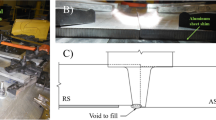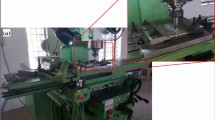Abstract
Friction stir welding (FSW) is a relatively new manufacturing process (invented in 1991 at the Welding Institute, UK) and more than 5000 scientific articles have been published in the past 10 years in indexed journals demonstrating the robustness of the research. However, further research is necessary to ensure safe use of the technique for structural components, particularly with reference to the aeronautics industry. Residual stresses and their consequences on the life of welded products must be fully understood, in addition to their correlations with other properties such as hardness, strength, and microstructure. This paper is a part of the research being conducted to evaluate the impact of four FSW techniques (bobbin, top-sided, bottom-sided, and double-sided) on the mechanical properties in dissimilar thick joints (12.7 mm) of aluminum alloys (AA7181-T7651 and AA7475-T7351) used in the aeronautics industry. The residual stresses were measured using the incremental blind hole technique and analyzed using the integral method. The longitudinal residual stresses were all positive, with values between 100 and 200 MPa in the stir zone, whereas the transverse ones were all negative, with values between 0 and − 100 MPa. It was possible to verify that the Bobbin process produced lower values of residual stresses and demonstrated better stability in its distribution compared to all the other FSW methods tested.
















Similar content being viewed by others
References
Thomas WM, Nicholas ED, Needham JC, Murch MG, Temple-Smith P, Dawes CJ (1991) Improvements relating to friction welding. GB patent no:9125978–9125978
Wu H, Chen Y, Strong D, Prangnell P (2015) Stationary shoulder FSW for joining high strength aluminum alloys. J Mater Process Technol 221:187–196
Padhy GK, Wu CS, Gao S (2017) Friction stir based welding and processing technologies - processes, parameters, microstructures and applications: a review. J Mater Sci Technol 14:1–38
Wang FF, Li WY, Shen J, Wen Q, Santos JF (2018) Improving weld formability by a novel dual-rotation bobbin tool friction stir welding. J Mater Sci Technol 34:135–139
Esmaily M, Mortazavi N, Osikowicz W, Hindsefelt H, Svensson JE, Halvarsson M, Martin J, Johansson LG (2016) Bobbin and conventional friction stir welding of thick extruded AA6005-T6 profiles. Mater Des 108:114–125
Xu W, Liu J (2015) Microstructure evolution along thickness in double-side friction stir welded 7085 Al alloy. Trans Nonferrous Metals Soc China 25:3212–3222
Goebel J, Reimann M, Norman A, Santos FF (2017) Semi-stationary shoulder bobbin tool friction stir welding of AA2198-T851. J Mater Process Technol 245:37–45
Xu W, Luo Y, Zhang W, Fu MW (2018) Comparative study on local and global mechanical properties of bobbin tool and conventional friction stir welded 7085-T7452 aluminum thick plate. J Mater Sci Technol 34:173–184
Cetkin E, Çelik YH, Temiz S (2019) Microstructure and mechanical properties of AA7075/AA5182 jointed by FSW. J Mater Process Technol 268:107–116
Bertrand R, Robe H, Texier D, Zedan Y, Feulvarch E, Bocher P (2019) Analysis of AA2XXX/AA7XXX friction stir welds. J Mater Process Technol 271:312–324
Jimenez-Mena N, Sapanathan T, Drezet JM, Pirling T, Jacques PJ, Simar A (2019) Residual stresses of friction melt bonded aluminum/steel joints determined by neutron diffraction. J Mater Process Technol 266:651–661
Yu H, Zheng B, Lai X (2018) A modeling study of welding stress induced by friction stir welding. J Mater Process Technol 254:213–220
Papan H, Bahemmat P, Haghpanahi M, Valipour A (2014) Ultrasonic measurements of residual stresses caused by severe thermomechanical deformation during FSW. Exp Mech 54:1587–1596
Ji P, Yang Z, Zhang L, Ji V, Klosek V (2015) Residual stress distribution and microstructure in the friction stir weld of 7075 aluminum alloy. J Mater Sci 50:7262–7270
Aval HJ (2015) Microstructure and residual stress distributions in friction stir welding of dissimilar aluminum alloys. Mater Des 87:405–413
Haghshenas M, Gharghouri MA, Bhakhri V, Klassen RJ, Gerlich AP (2017) Assessing residual stresses in friction stir welding: neutron diffraction and nanoindentation methods. Int J Adv Manuf Technol 93:3733–3747
Cabibbo M, Forcellese A, Mehtedi E, Simoncini M (2014) Double side friction stir welding of AA6082 sheets: microstructure and nanoindentation characterization. Mater Sci Eng A 590:209–217
Sahu PK, Pal S (2017) Mechanical properties of dissimilar thickness aluminum alloy weld by single/double pass FSW. J Mater Process Technol 243:442–455
Ahmeda MMZ, Ataya S, Seleman MMS, Ammar HR, Ahmed E (2017) Friction stir welding of similar and dissimilar AA7075 and AA5083. J Mater Process Technol 242:77–91
Zapata J, Toro M, López D (2016) Residual stresses in friction stir dissimilar welding of aluminum alloys. J Mater Process Technol 229:121–127
Author information
Authors and Affiliations
Corresponding author
Ethics declarations
Conflict of interest
The authors declare that they have no conflict of interest.
Additional information
Publisher’s note
Springer Nature remains neutral with regard to jurisdictional claims in published maps and institutional affiliations.
Rights and permissions
About this article
Cite this article
Delijaicov, S., Rodrigues, M., Farias, A. et al. Microhardness and residual stress of dissimilar and thick aluminum plates AA7181-T7651 and AA7475-T7351 using bobbin, top, bottom, and double-sided FSW methods. Int J Adv Manuf Technol 108, 277–287 (2020). https://doi.org/10.1007/s00170-020-05370-2
Received:
Accepted:
Published:
Issue Date:
DOI: https://doi.org/10.1007/s00170-020-05370-2




